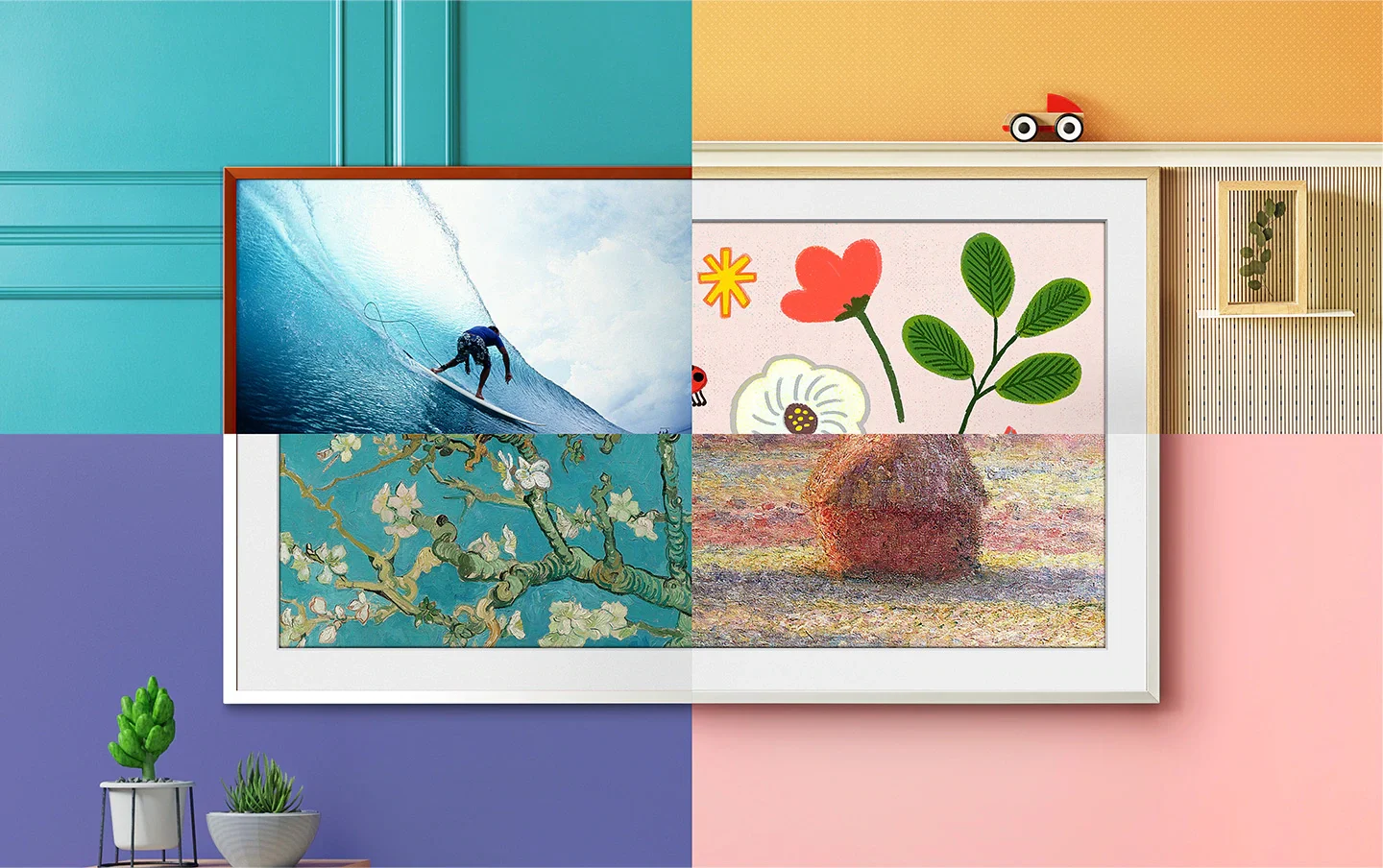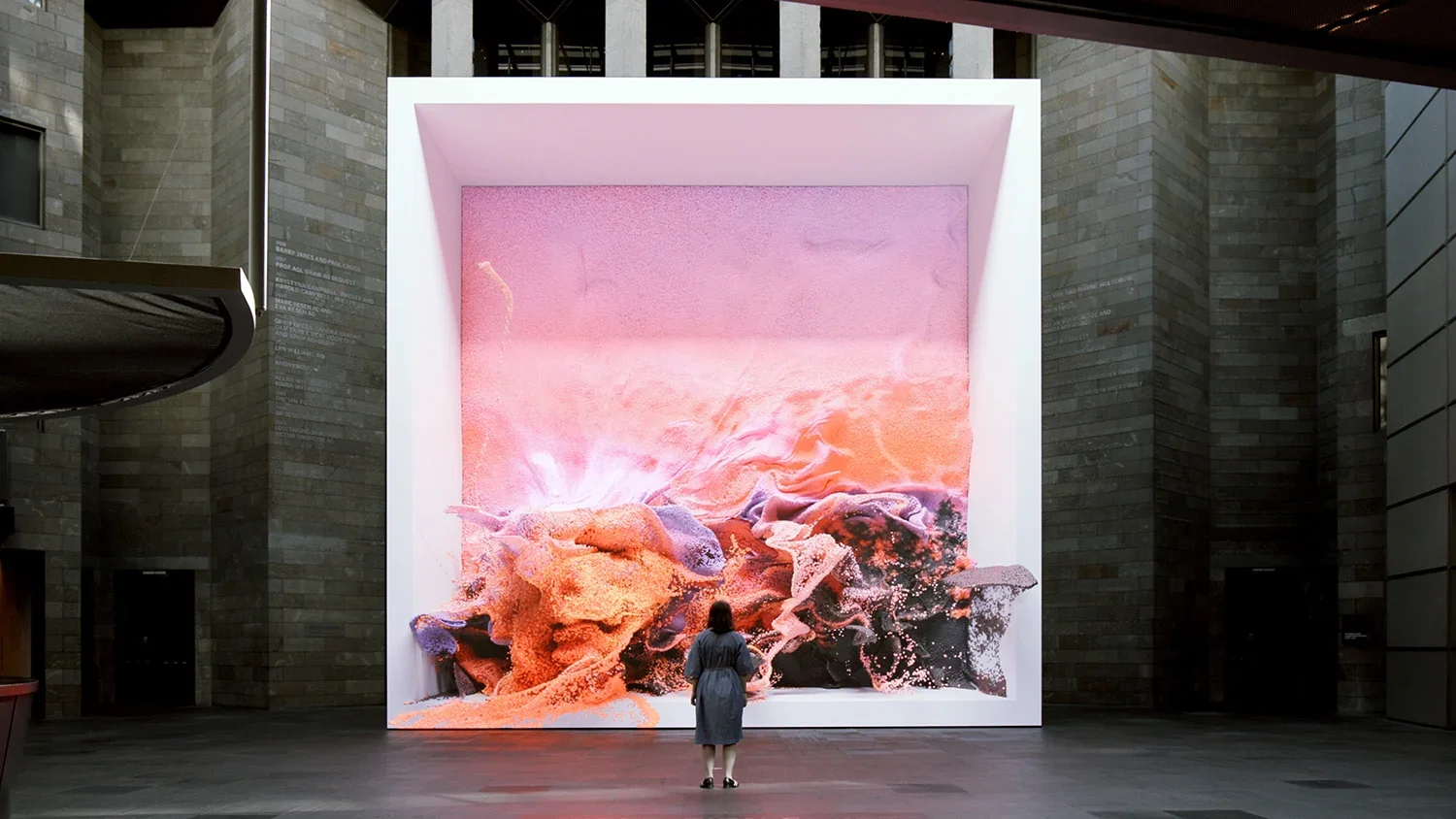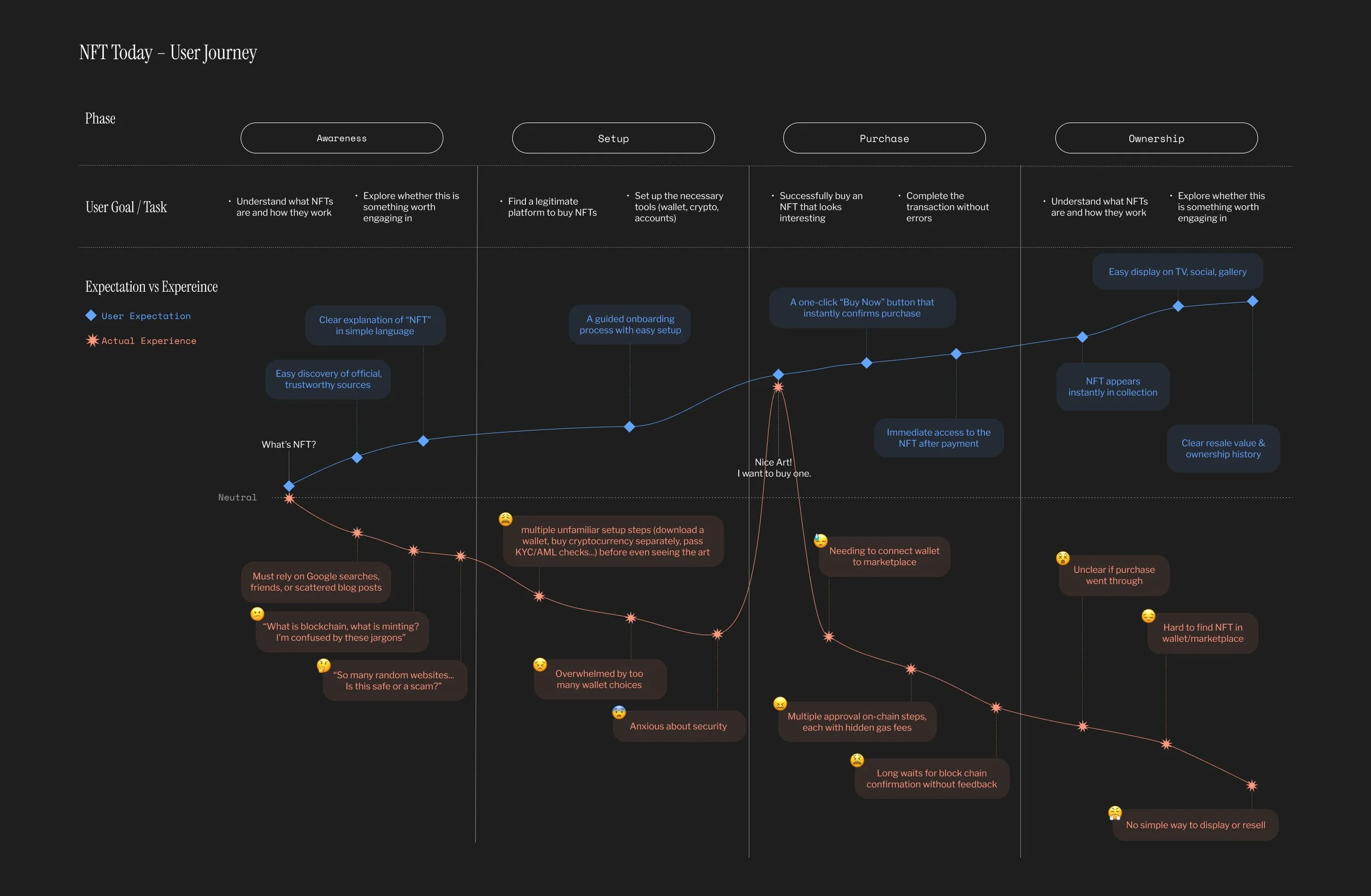
Reimagining the Frame’s Art Store as a digital canvas for discovery, ownership, and resale
Samsung ArtStore:
Digital Art Marketplace
Scroll ↓
From static subscription to a living marketplace for digital art
The Frame TV was designed to be more than a television — a digital canvas that brings art into everyday life. But its Art Store experience wasn’t living up to that promise. Most Frame owners never subscribed, and those who did often dropped off during a broken sign-up flow. Content felt stale, the free tier was too generous, and users saw Art Mode as “wallpaper” rather than a platform worth paying for.
At the same time, digital art and NFTs were booming, yet mainstream platforms were confusing, speculative, and far from TV-friendly. This created an opportunity to reimagine the Art Store as a seamless subscription and digital art marketplace where people could discover, own, and resell works — with the Frame as the ultimate display.
The Opportunity
The gap was clear: Frame owners wanted effortless access to art they could trust, while digital art enthusiasts wanted a simpler way to participate in ownership and resale. By bridging these needs, Samsung had the chance to transform the Art Store from a stagnant subscription service into the #1 platform for digital art in the home.
My Role
I was part of a small design team, consisting of a design director and another product designer. Together, we conducted multiple ideation sessions and explored directions across both TV and web platforms.
I was responsible for:
Designing UX flows and UIs for Exclusive Drop and Selling Art on TV
Creating UX flows and UIs for One-Click Buy and My Collection on web
Collaborating with PM, engineering, and business stakeholders to align design with strategy
Turning complex ownership and resale concepts into simple, trustworthy user experiences
Problem & Opportunity:
From stagnant service to an engaging art platform
Samsung Art Store 1.0 was built as a subscription service, but the model wasn’t working.
Too many upfront barriers and coupon codes made it difficult for owners to even try.
Nearly half of those who attempted to subscribe failed during the Samsung Account and Checkout.
The free tier gave away too much, leaving little incentive to pay.
Engagement was minimal: only 2.5% of users spent more than a minute in the store each week, and just 1.5% searched for art.
Beyond that, the experience was fragmented across devices and surfaces. Maintaining multiple UX versions created duplication, slowed down operations, and made it difficult for the Art Store to scale as a unified global service.
ArtStore 1.0 Design. Monotonous grid design without any personalization.
At the same time, digital art was gaining cultural momentum, but NFT platforms were intimidating and overly complex. This revealed a clear opportunity: streamline access, unify the experience across devices, and reposition the Art Store as both a subscription and a marketplace where users could discover, own, and resell digital art — with the Frame as the ultimate display.
Who we were designing for:
Frame TV Owners & Digital Art Enthusiasts
The Art Store had to serve two very different but equally important audiences. On one side were Frame TV owners — people who bought the device for its design value, expecting a seamless way to enrich their living space with art. On the other hand, there were digital art enthusiasts — a growing segment drawn to the rise of NFTs and collectibles, motivated by ownership and exclusivity but frustrated by the complexity of existing platforms.
To succeed, the Art Store needed to meet the needs of both groups: make digital art feel approachable for everyday users while still offering depth and value for collectors.
Frame Owners
Affluent, design-conscious consumers who purchased the Frame to enhance their living spaces.
Wanted their TV to feel like a curated gallery, but struggled with friction-heavy sign-up flows and underwhelming discovery.
Many were satisfied with the free tier and didn’t see enough value to pay.
Digital Art Enthusiasts
A younger, tech-savvy audience experimenting with NFTs and digital collectibles.
Motivated by the thrill of ownership and exclusivity, but turned away by crypto jargon, wallets, and speculative marketplaces.
Needed an entry point that felt curated, trustworthy, and integrated with their everyday devices.
Design Principles
Based on user research and market analysis, we defined three design principles to guide the transformation from a static subscription model to a living marketplace.
01 Immersive Discovery
How do we make the Art Store feel less like a static grid and more like a living gallery?
Editorialized curation — highlight artists, movements, and stories to give context and depth.
Exclusive drops with notifications — build urgency and anticipation into discovery.
Discover art, artists, and art news — expand beyond static images into cultural content.
02 Effortless Flow
Art ownership should feel no harder than renting a movie.
Buy art directly on the Frame or web, with fiat-based checkout.
Display art instantly after purchase, bridging learning and doing.
List art for resale without crypto hurdles.
03 Guided Ownership
Make digital art ownership tangible and trustworthy.
Ownership indicators — show what’s owned and its provenance.
Value overview — track what users have earned through their collection.
Market price view — surface real-time resale context.
Design Solutions:
From discovery to ownership
01 Simplifying Digital Ownership
NFT platforms turned digital ownership into an obstacle course.
To buy a single piece of art, users first had to download a crypto wallet, learn unfamiliar concepts like gas fees, and pass identity checks just to move funds around.
Every step introduced new jargon, multiple approvals, and long wait times — leaving most people anxious, confused, and often giving up before they ever saw their purchase.
For Frame TV owners, this level of friction was unacceptable. They expected art to be as easy to access as streaming music or movies — instant, intuitive, and trustworthy.
02 Reframing Discovery: Turning browsing into inspiration
Art Store 1.0 made discovery feel transactional and flat — endless grids of static thumbnails with little curation or story. For Frame users who saw their TV as an extension of their living space, this approach felt uninspired and disconnected from the emotional value of art.
We saw an opportunity to move from a transactional catalog to a curated, human experience — one that evokes emotion and curiosity. We redefined the discovery journey around storytelling, immersion, and anticipation.
Exclusive Drops
In 1.0, discovery had no sense of timing or anticipation — users could browse anytime but rarely felt compelled to return. We introduced Exclusive Drops to bring energy, anticipation, and urgency into the experience.
These were limited-time releases with restricted availability, designed to make discovery feel dynamic and collectible.
By introducing scarcity, we shifted the psychology from casual browsing to intentional engagement — turning curiosity into purchase intent. Each drop felt rare, time-sensitive, and worth acting on, reinforcing the sense that owning digital art could be as thrilling as acquiring a physical piece.
03 Extending Ownership Experience
In Art Store 1.0, the journey ended after purchase — users could display art, but the experience was static. With 2.0, we aimed to extend ownership beyond display: making it active, expressive, and even financially rewarding.
The Frame became not just a digital canvas, but a connected platform where users could curate, showcase, and trade their owned art.
Simplified Resale Flow
The NFT resale process had traditionally been scattered across multiple platforms and steps — listing, pricing, tracking bids, all detached from the ownership surface itself.
We redesigned the resale experience directly within the Frame UI, bringing every key element into one simple flow:
Simplified Listing: Users can re-list owned works in just a few taps, without navigating to external marketplaces.
Integrated Pricing Insights: The Frame displays real-time price history, recommended price range, and market trends so users can make informed decisions at a glance.
Monetization Breakdown: A transparent view of revenue share, platform fees, and potential earnings — all in one place.
Editorialized Collections
Instead of displaying artworks as isolated images, we introduced editorialized collections that framed art within a narrative context.
Each collection was curated around a theme — a movement, a mood, or a cultural moment — giving users a reason to explore deeper.
By highlighting artist stories, design notes, and contextual pairings, the Art Store became more than a gallery; it became a guided journey through meaning and emotion.
This approach humanized digital art, helping users connect with why a piece mattered, not just what it looked like.
Virtual Exhibitions
After purchasing, users could curate and display their owned artworks as personalized, ambient galleries on the Frame.
Each exhibition could be themed by artist, mood, or collection, transforming the Frame into a living art showcase that evolves with the user’s taste.
To deepen the sensory experience, we also introduced Spotify integration — allowing users to pair playlists or soundscapes with their digital exhibitions.
This bridged visual and auditory moods, letting users create fully immersive atmospheres — for example, playing calm jazz while displaying an impressionist collection, or ambient electronica alongside digital abstracts.
Virtual Exhibitions redefined what ownership feels like — not just displaying art, but curating the emotion of a space.
By visualizing the entire resale ecosystem within the Frame, we turned a traditionally technical, intimidating process into something transparent, empowering, and immediate.
Ownership became a loop — discover, buy, display, resell — all within the same surface.
We reimagined the flow to be frictionless, hiding blockchain under the hood while keeping ownership benefits visible
Buy with one click — pay directly with card, no crypto or wallets needed.
See it instantly — your artwork appears on the Frame within seconds.
Own it clearly — provenance and ownership status shown right in the UI.
Concept Takeaway: A proof of concept exploring the future of art in the home
Art Store 2.0 reimagined what digital ownership could mean on the Frame.
Through this proof of concept, we explored how the TV could evolve beyond passive display — becoming a platform where users discover, own, and interact with art in more meaningful ways.
The project demonstrated the potential to transform the Art Store from a static subscription service into a dynamic marketplace for digital art — one that seamlessly connects inspiration, ownership, and participation across multiple surfaces.
While still a concept, it defined a clear vision for how Samsung could lead the next era of digital art consumption and ownership in the home.
Confidentiality note:
Certain details of this project have been intentionally omitted for confidentiality reasons.
If you’d like to dive deeper into the UX strategy and results, feel free to reach out to thisisheej@gmail.com —I’d love to chat.





